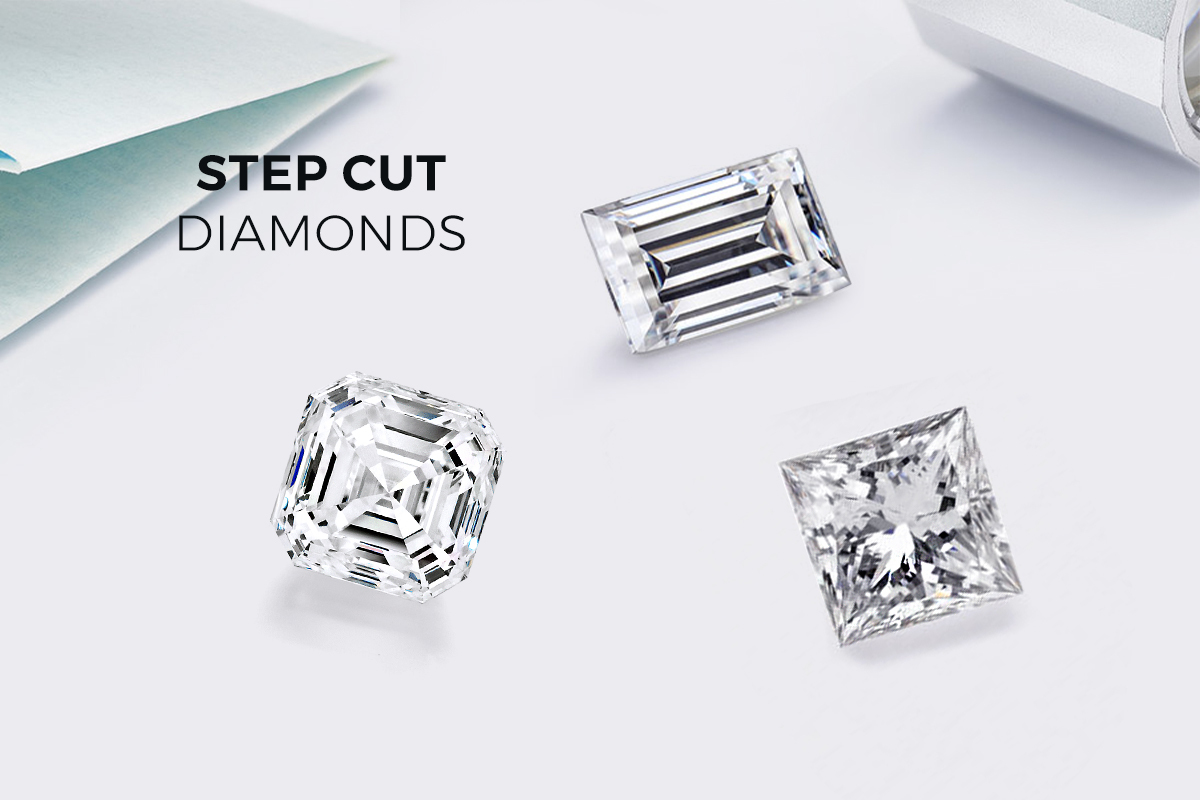A Beginner’s Guide to Step Cut Diamonds: Types Explained
Ever wondered why emerald and asscher diamonds look so timeless yet different from sparkling round brilliants? The secret lies in their step cut faceting.
Step cut diamonds are loved for their clean lines, architectural beauty, and calm elegance. They don’t sparkle as much as brilliant cuts, but they deliver a refined “hall of mirrors” glow that jewelry collectors and brides-to-be admire.
For inspiration, consider classic emerald-cut solitaire rings, vintage-inspired asscher cut halos, or three-stone step cut diamond settings that highlight the distinct geometry and elegance of these cuts. Each offers a unique take on the step cut style while showcasing its mesmerizing play of light.
Step cut diamonds are loved for their clean lines, architectural beauty, and calm elegance. They don’t sparkle as much as brilliant cuts, but they deliver a refined “hall of mirrors” glow that jewelry collectors and brides-to-be admire.
This guide will walk you through everything you need to know: what step cut diamonds are, how they compare to brilliant cuts, the different types available, and expert tips for choosing the perfect one.
What are Step Cut Diamonds?
Step cut diamonds are a family of diamond cuts that prioritize elegance, clarity, and geometry over intense sparkle. Instead of the many tiny facets found in brilliant cuts, step cuts use long, rectangular facets arranged in parallel rows, almost like a staircase, creating straight lines that contribute to their distinctive “hall of mirrors” effect, a graceful play of light and shadow that gives these diamonds their calm, sophisticated glow.
With their open tables and clean lines, step cuts highlight the diamond’s natural transparency, making clarity and color especially important when choosing one.
Popular styles include the emerald cut, Asscher cut, and baguette cut, each offering its own balance of vintage charm and modern sophistication.
If brilliant cuts are known for their fiery sparkle, step cuts are celebrated for their architectural beauty and timeless refinement, perfect for those who prefer understated luxury.
Difference Between Step Cut and Brilliant Cut Diamonds
The main difference lies in the faceting style:
| Feature | Step Cut Diamonds | Brilliant Cut Diamonds |
|---|---|---|
| Facet Style | Parallel, rectangular facets (“steps”) | Triangular/kite-shaped facets radiating from the center |
| Look & Feel | Elegant, architectural, “hall of mirrors” effect | Maximum sparkle, intense fire, lots of scintillation |
| Sparkle | Subtle, calm glow, less sparkle | High brilliance and fire, very sparkly |
| Clarity | Shows inclusions and flaws more easily | Masks inclusions better due to sparkle |
| Best Used For | Showcasing clarity, vintage/art deco style | Classic sparkle, glamorous, modern look |
| Popular Shapes | Emerald, Asscher, Baguette | Round, Oval, Princess, Pear, Radiant |
Are Step Cut Diamonds More Expensive?
No, step cut diamonds usually cost less than brilliant cut diamonds when you’re comparing stones of the same size and quality.
This makes step cuts a great choice if you want something elegant and unique without spending as much.
Why are step cut diamonds often more affordable? A few key reasons:
- They’re easier and more efficient to cut, so less of the rough diamond goes to waste.
- They aren’t as popular as brilliant cuts (especially the classic round), so demand, and thus prices, stay lower.
- Their wide, flat facets show imperfections more easily, meaning only very clear diamonds are chosen for step cuts, but even then, they don’t fetch as high a price because of the quieter, softer sparkle.
The History and Evolution of Step Cut Diamonds in Jewelry Design
Step cut diamonds go back to the early 1900s. At that time, the Art Deco era was very popular.
People loved geometric designs and modern shapes with clean lines. The Asscher cut, made by Joseph Asscher, is a great show of this style. It has a square shape and parallel lines that stand out.
Over time, step cut diamonds grew to include new looks, like the emerald cut and the baguette cut. These classic styles are still loved today. They mix old traditions with new ways to look good.
Exploring Popular Types of Step Cut Diamonds
There are many ways that step-cut diamonds can showcase beauty and style. Emerald cut diamonds are loved for their clean lines and long, rectangular shape.
The asscher cut is square and gives a modern touch to a vintage look.
Baguette diamonds feature long, rectangular facets and are ideal as side stones or accents in fine jewelry, including stunning stone engagement rings.
If you want something more unique, try the octagon, hexagon, half moon, trapezoid, or carré cut. Let’s take a detailed look at each.
Emerald Cut Diamonds

Emerald cut diamonds have a rectangular shape with clean lines and fewer facets. The step-cut style makes these stones look special, like something from the art deco era. The large table at the top helps create a unique look by showing off the diamond’s clarity and letting light play over the surface.
Because emerald cut diamonds have fewer facets than most cuts, they need higher clarity grades to look their best. That’s one reason why emerald cut diamonds are a popular choice for engagement rings. They stand out with style and give you an eye-catching, architectural beauty.
Asscher Cut Diamond
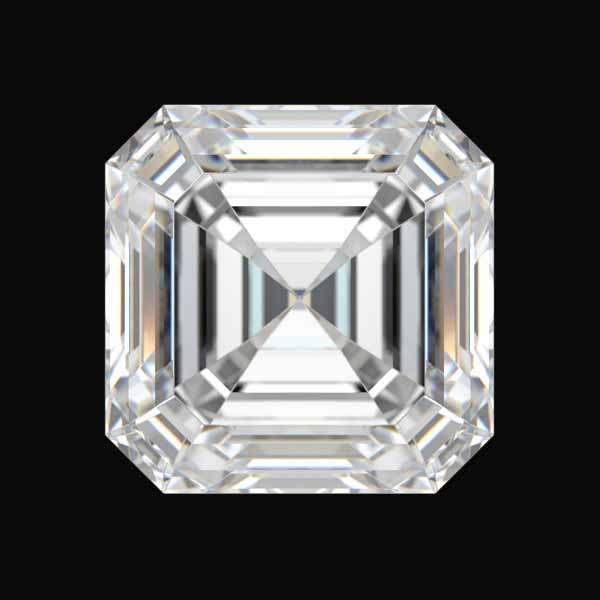
Known for its square shape and chopped edges, the Asscher cut stands out with its step cut facets. This style offers a classic look of beauty. It gets its name from Joseph Asscher, a famous jeweler.
The diamond shows off clean lines. The parallel facets give a hall of mirrors look. The asscher cut looks great with higher clarity grades, so people pick it for a unique look. Often, it is used as the center stone in engagement rings. The style fits both old and new designs, so many people enjoy it.
Baguette Diamonds
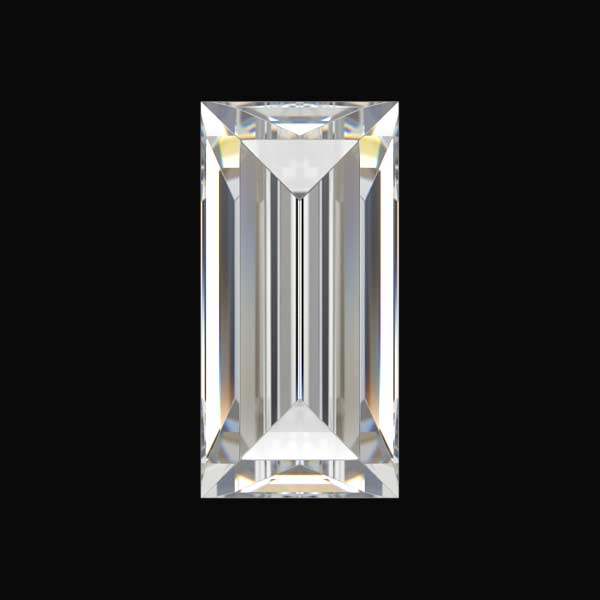
Baguette diamonds have a sleek, rectangular shape with parallel sides. The clean lines give a classic and modern style that many people like in fine jewelry. You see them often used as side stones in engagement rings, where they help the larger diamond stand out and add to the look.
These diamonds have fewer facets, which gives them a unique look and lets you see their clarity and shine. You can find baguette diamonds in different designs, like a three stone setting or as the focus of a statement piece. Their simple shape and fewer facets bring a timeless elegance that works with many jewelry collections.
Octagon Step Cut Diamond
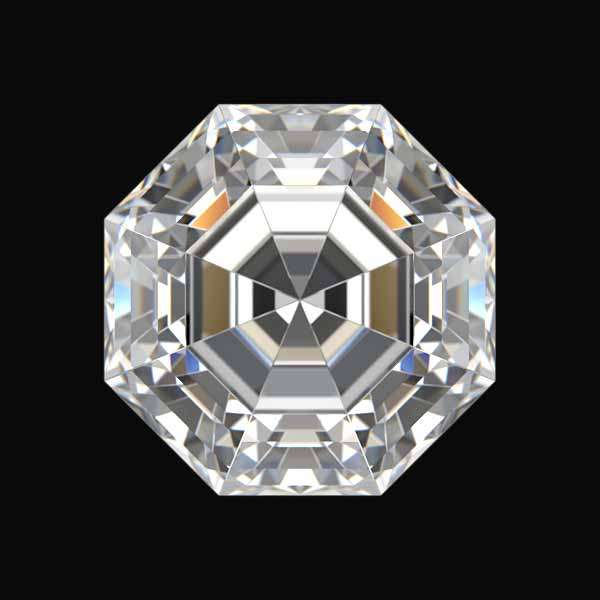
The octagon step cut is a beautiful pick in fine jewelry. It has eight sides that give it a special look. You will see clean lines and even shapes in this cut. This shape lets the light move in a way that is inviting and fresh. The step cut is good for people who want something new but still classic.
Octagon step cut diamonds can make any engagement ring or piece stand out. It is great for those who want their jewelry to look both up-to-date and stylish for a long time.
Hexagon Step Cut Diamond
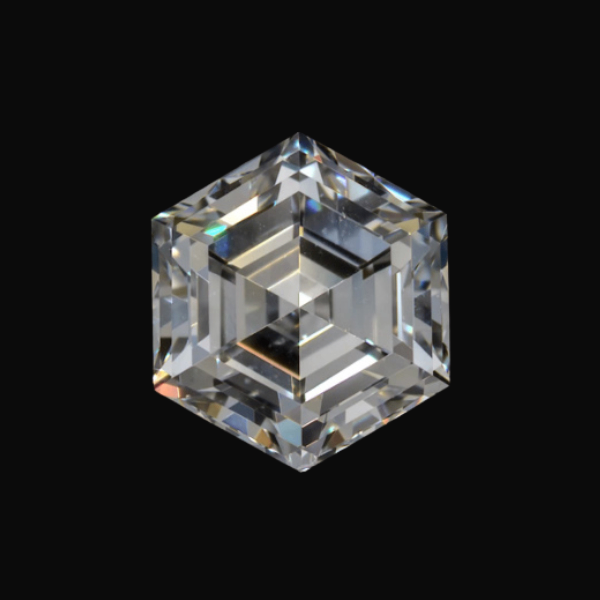
A hexagon step cut diamond brings a fresh, modern look with its six-sided shape. It fits well with today’s design trends. This special step cut has flat sides and parallel lines. They help show off the stone’s clarity and shine. If you want something not traditional, this cut diamond is a good choice.
It goes with both simple and more detailed settings. The hexagon step cut works well as a center stone for an engagement ring or as a bright detail in other fine jewelry.
Half Moon Step Cut Diamond
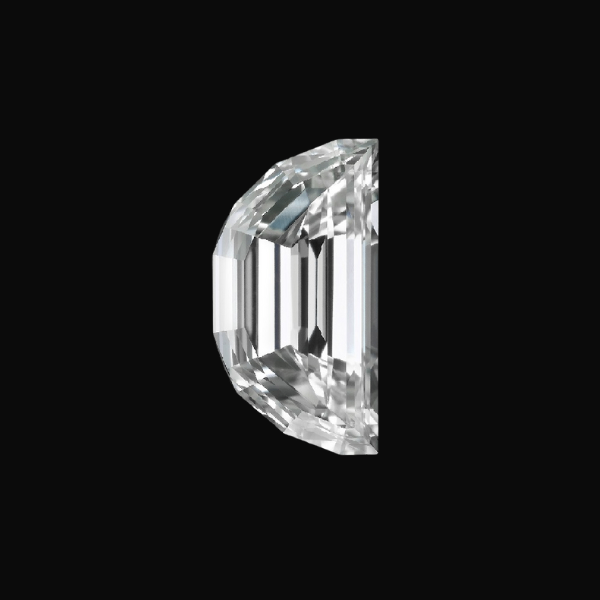
This diamond shape stands out because it has soft, curved sides. The step cut gives this cut diamond a clean and bright appearance. People often use the half moon step cut diamond as a side stone. It goes well with many fine jewelry designs and brings an artsy feel to each piece.
Its unique look lets light dance across the diamond. This look is much like the style from the Art Deco era. The clear shine and different shape help your center stone look even better. That’s why the half moon step cut diamond is a popular choice, giving off charm and beauty every time.
Trapezoid Step Cut Diamond
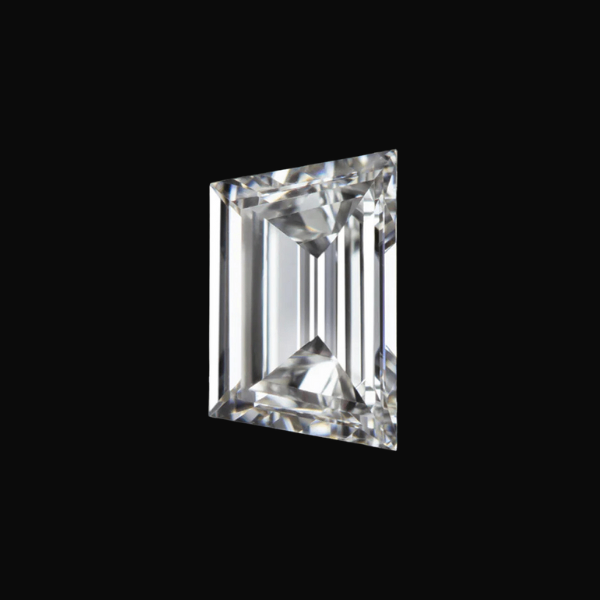
Trapezoid step cut diamonds are a great choice for anyone who wants something different from normal cuts, and they are most popular for a three-stone diamond ring with an oval cut diamond in the center.
They have a special look because of their tapered shape and the way the parallel lines run. The clean lines give these diamonds a modern style. They are often used as side stones, which helps to make the center diamond stand out even more in an engagement ring.
It reflects light in a way that is both simple and beautiful. If you like diamonds that can give you both a unique and elegant look, these are a good pick. These diamonds are a good way to make any collection look new and fresh.
Carré Cut Diamond
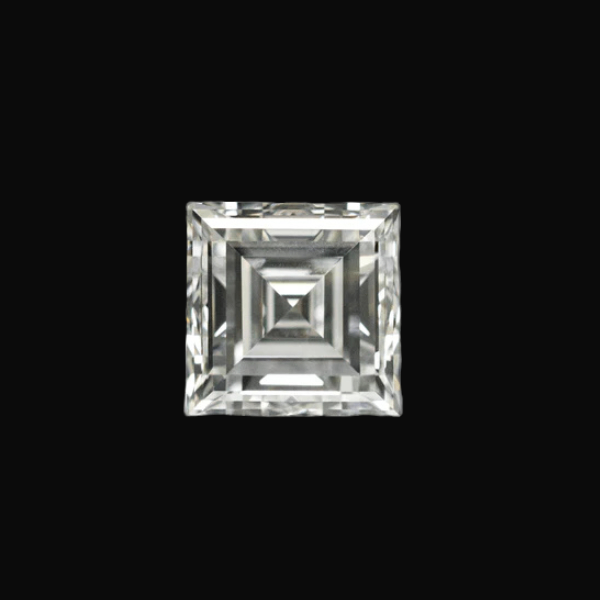
A carré cut diamond has a square shape and sharp corners with parallel edges. This diamond, often compared to a princess cut, is basically a square step cut diamond and does not reflect light as much as other diamonds, but it still holds its elegance.
The cut shows off clean lines and straight facets, making the stone shine and stand out. This look gives it a modern style, so it is a popular choice for new jewelry designs.
People like how it highlights higher clarity grades. The design also has a feel that reminds you of the Art Deco era. The carré cut can work well with many styles because of its versatility.
Pros and Cons of Step Cut Diamond for Engagement Rings
Step-cut diamonds are a good choice for diamond engagement rings. But you should think about whether you want more sparkle, because step cut diamonds do not shine like round cut or brilliant cut diamonds.
Apart from that, you also need to look at the cost and pick the right setting for the ring. That way, you will get the look you want.
Advantages: Subtle Look, Unique Faceting, and Versatility
- Shows Off the Best Gems: Step cuts let the clarity and color of a diamond shine! If you pick a high-quality stone, you’ll see its natural beauty more clearly than with any other cut.
- Modern, Minimalist Vibe: The sharp, clean lines look super fresh and go great with contemporary or simple jewelry designs.
- Gentler on Brittle Gems: Because of their broad, flat facets, step cuts are a bit kinder to more delicate stones, less likely to break during cutting.
- Vintage Charm: If you love an Art Deco or antique look, step cuts have loads of old-school glamour. They’re a favorite with collectors and anyone into timeless style.
- Perfect for Large Stones: Step cuts make bigger diamonds look even grander! The shape draws the eye and makes the most of the stone’s size.
- Always Stylish: Their calm, mirror-like glow is super elegant. You’ll never get tired of their quiet sophistication.
Considerations: Sparkle, Cost, and Setting Styles
- Not Super Sparkly: If you want your diamond to sparkle like crazy, step cuts might feel a little mellow. They glow, they don’t “bling.”
- Flaws are Easier to See: The big, clear facets make it easier to spot any imperfections, so buying higher clarity is smart.
- Lots of Rough Stone is Lost: These cuts use up more of the original diamond, which can mean a bit more waste, and sometimes makes bigger, flawless step cuts a bit pricier.
- Corners Can Chip: The sharp corners can be delicate, so you’ll want to be a little more careful when wearing and storing them.
- Not Best for Tiny Stones: They shine in bigger sizes. On smaller diamonds, the grand effect is a bit lost.
How Different Settings Change the Look of Step Cut Diamonds
When getting a step cut diamond, whether it’s in the form of an engagement ring or any other piece of jewelry, it is important to look for a perfect setting. Setting in the sense of how your diamond is set on the metal, if you want to highlight the diamond clarity and sparkle, get a 4 or 6 prong setting, and if you want something subtle, you can go with a bezel setting or a half bezel setting, which are currently in trend. Additionally, consulting a professional jeweler can help you explore other settings you can go with. Let’s take a quick look at each.
- Prong Setting:
This is the classic “claws” look, with the diamond held in place by tiny prongs. It lets in tons of light, so you get maximum shine and can appreciate the step cut’s crisp lines. - Bezel Setting:
Here, a rim of metal wraps around your diamond. It makes the ring super secure (less worry about bumps and knocks) and adds a clean, modern twist. If you like a sleek, minimalist look (or need something tough for everyday wear), the bezel is your friend. - Channel or Bar Setting:
Imagine your diamonds lined up like little tiles in a row, set snugly between strips of metal. This setting is fab for adding step cut baguettes to bands or as accents. It gives a cool Art Deco vibe that feels timeless and stylish. - Halo Setting:
Love a little extra sparkle? A halo setting frames your step cut diamond with a circle of smaller, glittery stones. This adds some serious dazzle and makes your center stone look much more dramatic, while still keeping that sophisticated “hall of mirrors” step cut look. - Three-Stone/Side Stone Setting:
Perfect if you want a little more personality, side stones can make your main diamond appear larger and add visual interest. Whether you’re celebrating a big life moment or just love a unique ring, this is a great choice. - Flush Setting:
This one sets the stone even with the surface of the ring; nothing sticks out, so it’s great for active folks who want to keep it simple and smooth.
FAQs
How does the appearance of step-cut diamonds compare to brilliant cuts?
Step-cut diamonds have a straight and neat look. They have fewer facets, which gives them a calm and old-school feel. On the other hand, brilliant cuts use many facets. This is to make the diamond shine more and catch your eye.
What clarity and color should I look for in step cut diamonds?
When you pick step cut diamonds, it is good to go for clarity grades of VS2 or above. This helps make sure there are hardly any marks or spots in the diamond. For color, try to choose G-H grades. These make the diamond look almost colorless.
In addition to these considerations, pay attention to the carat weight, as it can also enhance the appeal of step cut diamonds. These picks bring out the best in the step cut style. They help the diamond look shiny and beautiful, so it stands out.
Are lab-grown step cut diamonds different from natural ones?
Lab-grown step-cut diamonds and natural diamonds are the same when it comes to how they look, feel, and what they are made of. The big thing that makes them different is where they come from.
Lab-grown diamonds are made by people in places that can be controlled. These diamonds often cost less. Natural diamonds are made deep under the ground over a long time.

